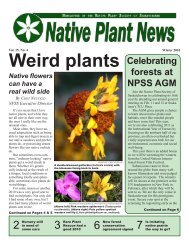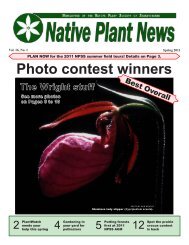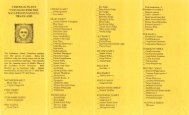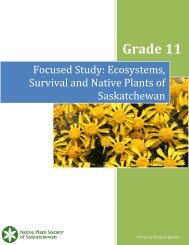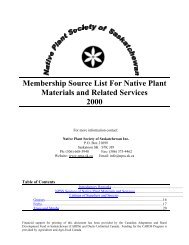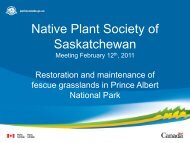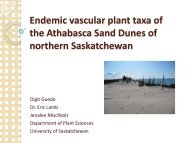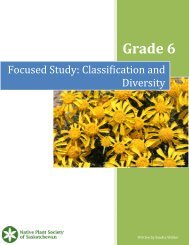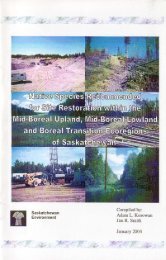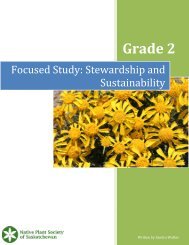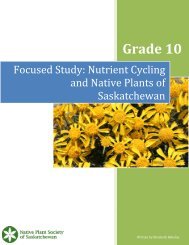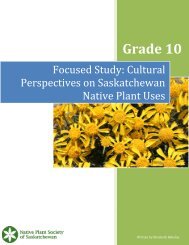Grade 9 Lesson Plan - Native Plant Society of Saskatchewan
Grade 9 Lesson Plan - Native Plant Society of Saskatchewan
Grade 9 Lesson Plan - Native Plant Society of Saskatchewan
Create successful ePaper yourself
Turn your PDF publications into a flip-book with our unique Google optimized e-Paper software.
<strong>Grade</strong> 9<br />
Focused Study: <strong>Plan</strong>t<br />
Reproduction and <strong>Native</strong> <strong>Plan</strong>ts<br />
<strong>of</strong> <strong>Saskatchewan</strong><br />
Written by Elizabeth Bekolay
The <strong>Native</strong> <strong>Plan</strong>t <strong>Society</strong> <strong>of</strong> <strong>Saskatchewan</strong> is a strong advocate <strong>of</strong> nature<br />
education.<br />
In addition to this lesson plan, we also support schools by:<br />
- providing free printed resources.<br />
- leading field tours.<br />
- delivering outdoor and classroom presentations.<br />
- hosting opportunities to "ask an expert", where students can interact with a pr<strong>of</strong>essional biologist or<br />
related occupation though in person events or Skype. In some cases, we can arrange for French<br />
speaking experts.<br />
We also support the establishment <strong>of</strong> native plant learning gardens on school grounds by <strong>of</strong>fering free<br />
native seeds, printed resources, personal visits, presentations and expert advice to help with all stages<br />
<strong>of</strong> the process. The gardens can be as small as a square meter.<br />
All <strong>of</strong> what we do is always free for participating schools.<br />
Does any <strong>of</strong> this sound like something you'd want If so, please call us at (306) 668-3940 or e-mail us at<br />
info@npss.sk.ca<br />
Free Electronic Resources on the <strong>Native</strong> <strong>Plan</strong>t <strong>Society</strong> <strong>of</strong> <strong>Saskatchewan</strong> Website (www.npss.sk.ca)<br />
<br />
<br />
<br />
<br />
A Guide to Small Prairie Restoration - How to Grow Your Own Patch <strong>of</strong> <strong>Native</strong> Prairie<br />
<strong>Saskatchewan</strong>'s <strong>Native</strong> Prairie: Taking Stock <strong>of</strong> a Vanishing Ecosystem and Dwindling Resource (Also<br />
available in print)<br />
On the Prairie - A webpage on our site with a "Build a Prairie" game, field guide to prairie plants and<br />
animals, curriculum goodies like a English-Dakota language guide, and virtual reality panoramas <strong>of</strong><br />
prairie places<br />
The Watershed Game<br />
Free Printed Materials Available Through the <strong>Native</strong> <strong>Plan</strong>t <strong>Society</strong> <strong>of</strong> <strong>Saskatchewan</strong>:<br />
<br />
<br />
<br />
<br />
<strong>Native</strong> <strong>Plan</strong>ts, Water and Us! (Booklet)<br />
<strong>Native</strong> <strong>Plan</strong>ts, Water and Us! (Poster)<br />
<strong>Native</strong> <strong>Plan</strong>t Communities <strong>of</strong> <strong>Saskatchewan</strong> (Poster)<br />
<strong>Native</strong> <strong>Plan</strong>t Communities <strong>of</strong> <strong>Saskatchewan</strong> (Activity Sheet)
FOCUSED STUDY: PLANT REPRODUCTION AND NATIVE PLANTS OF<br />
SASKATCHEWAN<br />
GRADE 9<br />
OVERVIEW AND PURPOSE<br />
To form an understanding <strong>of</strong> the continuance <strong>of</strong> life in nature through a lesson on native plant<br />
reproduction, pollination, the reproduction <strong>of</strong> symbiotic species and the effects <strong>of</strong> differing types <strong>of</strong><br />
reproduction methods on populations.<br />
In groups or as individuals, each student will choose 4 native species as examples <strong>of</strong> differing types <strong>of</strong><br />
reproduction in the Kingdom <strong>Plan</strong>tae to study (out <strong>of</strong> our native trees, shrubs, forbs, mosses, grasses,<br />
cacti, ferns, algae, lichens or symbiotic organisms such as gall flies).<br />
A visit to a local ecosystem is integral to this study. If possible, visit two or more differing ecosystems:<br />
prairie, deciduous forest, coniferous forest, wetland, riparian area, bog, etc; whatever is most accessible<br />
to you.<br />
By focusing on a small number <strong>of</strong> plants, instead <strong>of</strong> many, a relationship can be built between the<br />
student and the plants. As John Muir wrote, ‘When one tugs at a single thing in nature, he finds it<br />
attached to the rest <strong>of</strong> the world.’ When a child can focus on something in nature, something tangible<br />
that holds a story, and an adult helps to illuminate that story by asking more questions, the child can<br />
begin to see the connections on their own as a revelation <strong>of</strong> their own exploration. This is the beginning<br />
<strong>of</strong> ecological literacy.<br />
OUTCOMES AND INDICATORS<br />
a. Identify questions to investigate about sexual and asexual reproduction in plants.<br />
b. Compare advantages and disadvantages <strong>of</strong> sexual and asexual reproduction for individual plants and<br />
animals, and for populations.<br />
c. Describe various methods <strong>of</strong> asexual reproduction in plant species (e.g., budding, grafting, binary<br />
fission, spore production, fragmentation, and vegetative reproduction) and list specific examples.<br />
f. Describe the process <strong>of</strong> sexual reproduction in seed-producing plant species, including methods <strong>of</strong><br />
pollination.<br />
MATERIALS<br />
Identification books (see resource list below). The internet (if possible). Pens, pencils, paper. Garbage<br />
bags (to clean the area where you visit <strong>of</strong> any litter that may be found).<br />
Free Publications from the <strong>Native</strong> <strong>Plan</strong>t <strong>Society</strong> <strong>of</strong> <strong>Saskatchewan</strong>:<br />
<strong>Native</strong> <strong>Plan</strong>ts, Water and Us!<br />
<strong>Native</strong> <strong>Plan</strong>t Communities <strong>of</strong> <strong>Saskatchewan</strong> Poster<br />
<strong>Native</strong> <strong>Plan</strong>t Communities <strong>of</strong> <strong>Saskatchewan</strong> Placemat<br />
<strong>Saskatchewan</strong>’s <strong>Native</strong> Prairie: Taking Stock <strong>of</strong> a Vanishing Ecosystem and Dwindling Resource<br />
INTRODUCTION<br />
By this grade level a student should have a good understanding <strong>of</strong> what a native plant is. However, it is<br />
always beneficial to reinforce and remind. A plant native or indigenous to <strong>Saskatchewan</strong> is one that has
evolved here. This means that it was here prior to European contact. <strong>Native</strong> plants are adapted to their<br />
specific climatic zone and soil type. There are both native aquatic plants and terrestrial plants. <strong>Plan</strong>ts<br />
that are not native are considered ‘introduced’ or ‘exotic’. If these introduced species spread rapidly<br />
and out-compete other plants in an ecosystem they are considered ‘invasive’ or sometimes referred to<br />
as ‘noxious weeds’. <strong>Native</strong> plants are part <strong>of</strong> the biodiversity that help to keep our ecosystems healthy.<br />
They support a vast number <strong>of</strong> species that have evolved with them in an intricate relationship. The loss<br />
<strong>of</strong> this biodiversity has an impact throughout the ecosystem resulting in species endangerment and<br />
extinction. It is important to promote a sense <strong>of</strong> respect through ecological knowledge <strong>of</strong> place.<br />
This study will include a focus on diverse species in the Kingdom <strong>Plan</strong>tae such as trees, shrubs, forbs,<br />
grasses and grass-likes (sedges and rushes), ferns and fern allies (other ancient plants similar to ferns),<br />
mosses, algae, and lichens.<br />
There are two methods <strong>of</strong> reproduction in plants:<br />
1. Sexual reproduction: Through pollination and meiotic spore formation.<br />
a. Animal pollination: Birds, butterflies, moths, bees, wasps, flies.<br />
b. Sexual spore formation: Mosses, ferns and fungi.<br />
2. Asexual Reproduction: Budding, vegetative reproduction, and mitotic spore formation.<br />
http://www.diffen.com/difference/Meiosis_vs_Mitosis<br />
INSTRUCTIONAL METHODS<br />
This is a guided inquiry. Do not collect whole plants for this study. Leaf collection may be helpful for<br />
identification. Taking several close-up pictures would greatly help with plant identification.<br />
Bring your students to a local ecosystem. In groups or as individuals have them explore the area, write a<br />
description and make a sketch <strong>of</strong> the habitat. Have them choose 4 different types <strong>of</strong> plant species based<br />
on differing reproductive methods.<br />
For example:<br />
Animal pollinated plants: Roses, primroses, asters, and most other plants with large, colourful flowers.<br />
Wind pollinated plants: Many poplars, willows, grasses.<br />
<strong>Plan</strong>ts that send out runners: Strawberry, dewberry.<br />
<strong>Plan</strong>ts that form rhizomes or root suckers: Star-flowered false Solomon’s seal, sarsaparilla, showy<br />
milkweed, cattail, raspberry, aspen.<br />
<strong>Plan</strong>ts that form spores: Fungi (sexual and asexual spore formation), lichens, mosses, ferns.<br />
<strong>Plan</strong>t association assisted reproduction: Goldenrod gallfly, willow gallfly, juniper-saskatoon berry rust.<br />
You would have to dig up the plants to see if they spread by rhizome; only do this if it is s<strong>of</strong>t humus and<br />
rhizomes can be exposed without causing damage to the plants. If that is not a possibility, ensure plants<br />
are chosen for 3 other reproductive methods listed above and ask the students to choose a plant<br />
without this knowledge, based on a guess, to be researched later.<br />
Make a sketch <strong>of</strong> the species they choose. Take pictures if possible. Have them look at every detail in<br />
order to help them identify their plants later. Or you can help them identify their plants on site if you<br />
bring an expert or native plant guides with you. Also look at what insects are visiting the plants, as it<br />
may give a clue to their method <strong>of</strong> reproduction.
The proper identification <strong>of</strong> the plant is important, but not the purpose <strong>of</strong> the study. Have the students<br />
identify their species as closely as possible. Determine whether the plant is native to <strong>Saskatchewan</strong> or<br />
introduced. If it is introduced try to discover where this plant has journeyed from and how. Ask the<br />
students to put themselves in the position <strong>of</strong> the plant: to observe the plant's surroundings and assess<br />
what it needs to survive and where they can obtain it from (and from how far away).<br />
Seek resources to help your students; a biologist, a herbalist, a knowledgeable parent or community<br />
member, books from the resource list, an interpretive/nature center and the internet. Mushrooms can<br />
be very difficult to identify; if you have a student up for the challenge they will have to create a spore<br />
print. http://www.mushroomexpert.com/spore_print.html<br />
The <strong>Native</strong> <strong>Plan</strong>t <strong>Society</strong> <strong>of</strong> <strong>Saskatchewan</strong> can help your students to identify their plants through email<br />
photo exchange or by a visit to your classroom or study location.<br />
Knowing which ecozone you are studying will really help to narrow the possibilities <strong>of</strong> species in the<br />
search for your species’ identity.
http://esask.uregina.ca/entry/ecozones_and_ecoregions.html<br />
Find your ecozone. Are you in<br />
the Prairie, Boreal Plain, Boreal<br />
Shield or Taiga Shield ecozone<br />
Locate your ecoregion to<br />
narrow your plant ID search.
Some botanical terminology may help your students understand the plant identification keys and plant<br />
descriptions:<br />
Chart <strong>of</strong> leaf morphology characteristics. Source: http://en.wikipedia.org/wiki/File:Leaf_morphology.svg<br />
Image credit: McSush/Debivort
Raceme Spike Corymb<br />
Umbel Panicle Catkin<br />
Chart <strong>of</strong> common inflorescence (flower) types. Source: http://en.wikipedia.org/wiki/Inflorescense<br />
Image credit: Amanda44, Shazz and Daniel Miłaczewski
ASSIGNMENT<br />
Once the student's species are identified and their method <strong>of</strong> pollination or reproduction determined<br />
ask your students to write a story, poem, or essay telling <strong>of</strong> how the plants survive. Alternatively they<br />
could create a poster or diagram. Their research should include the following information for each<br />
species:<br />
Common names (most plants have more than one).<br />
Latin name (look up the meaning <strong>of</strong> the Latin names).<br />
Method <strong>of</strong> reproduction (list possible pollinator species).<br />
Any stories <strong>of</strong> the plant type or species from visit with a Knowledge Keeper.<br />
Some answers to the inquiry questions below.<br />
Some questions that haven’t been answered and are still a mystery.<br />
Pictures or drawings <strong>of</strong> each species.<br />
Steps in this study: A summary<br />
1. Talk with your students about the purpose <strong>of</strong> the study – to have a hands-on experience in nature to<br />
figure out how individual species survive and reproduce in an ecosystem.<br />
2. It is optional, though very beneficial, to have an elder come into the class to share knowledge on<br />
plant communities with your students.<br />
3. <strong>Plan</strong> the trip together – is there a functioning native ecosystem near to the school If not, how far<br />
do you have to travel Have a discussion about this in terms <strong>of</strong> habitat loss and threats to<br />
biodiversity. Discuss the different reproductive strategies described above.<br />
4. Visit a native ecosystem, sketch the habitat, clean up the garbage and choose 4 different species to<br />
study. Try to choose 4 that have different reproductive strategies.<br />
5. Identify and determine the reproductive strategy <strong>of</strong> 4 different types <strong>of</strong> species (out <strong>of</strong> our native<br />
trees, shrubs, forbs, mosses, grasses, ferns, algae, or lichens).<br />
6. Have the students complete their assignment and generate further inquiry questions to accompany<br />
those listed above and below.<br />
INQUIRY<br />
Explore, observe, investigate, acknowledge sources, interpret, plan, and create.<br />
Questions: (These are not the essential questions to be answered; they are to help the teacher and<br />
students to explore the possibilities <strong>of</strong> what can be learned about their plant).<br />
How prevalent was this plant in its habitat Was it growing densely or were there few How does this<br />
relate to its reproductive method<br />
What does the habitat <strong>of</strong> these species look like Are they dry loving, sun loving, or moist and shade<br />
loving Which animals might use this plant How What other creatures did you see near this plant<br />
What other roles could this plant have in the ecosystem<br />
What is around the plant that can help it/harm it
ASSESSMENT<br />
Have the students share their research with each other in small groups. Invite community members to<br />
be involved in the presentations. Display the student research in a location where other students from<br />
your school can learn from it.<br />
RESOURCES<br />
Books:<br />
Aikenhead, G. and H. Michell. 2011. Bridging Cultures: Indigenous and Scientific Ways <strong>of</strong> Knowing<br />
Nature. Pearson Canada. Toronto.<br />
Grant, T. and Littlejohn, G. 2010. Greening School Grounds: Creating Habitats for Learning. New<br />
<strong>Society</strong> Publishers. Gabriola Island.<br />
Hammermeister, A., D. Gauthier and K. McGovern. 2001. <strong>Saskatchewan</strong>’s <strong>Native</strong> Prairie: Taking Stock<br />
<strong>of</strong> a Vanishing Ecosystem and Dwindling Resource. <strong>Native</strong> <strong>Plan</strong>t <strong>Society</strong> <strong>of</strong> <strong>Saskatchewan</strong>. Saskatoon.<br />
Johnson, D., L. Kershaw, A. MacKinnon, and J. Pojar. 1995. <strong>Plan</strong>ts <strong>of</strong> the Western Forest: Alberta,<br />
<strong>Saskatchewan</strong> & Manitoba Boreal Forest & Aspen Parkland. Lone Pine Publishing and the Canadian<br />
Forest Service. Edmonton.<br />
Keane, K. and D. Howarth. 2003. The Standing People: Field Guide <strong>of</strong> Medicinal <strong>Plan</strong>ts <strong>of</strong> the Prairie<br />
Provinces. Root Woman and Dave. Saskatoon.<br />
Kershaw, L. 2003. <strong>Saskatchewan</strong> Wayside Wildflowers. Lone Pine Publishing. Edmonton.<br />
Lahring, H. 2003. Water and Wetland <strong>Plan</strong>ts <strong>of</strong> the Prairie Provinces. Canadian Plains Research Center.<br />
Regina.<br />
Neufeld, C. 2010. <strong>Saskatchewan</strong>’s Prairie Places. <strong>Native</strong> <strong>Plan</strong>t <strong>Society</strong> <strong>of</strong> <strong>Saskatchewan</strong>. Saskatoon.<br />
<strong>Saskatchewan</strong> Indian Cultural Centre. 2009. Cultural Teachings: First Nations Protocols and<br />
Methodologies. Available through the <strong>Saskatchewan</strong> Indian Cultural Centre:<br />
http://www.sicc.sk.ca/index.html<br />
<strong>Saskatchewan</strong> Indian Cultural Centre. 2009. Practicing the Law <strong>of</strong> Circular Interaction. First Nations<br />
Environmental & Conservation Principles Binder. Available through the <strong>Saskatchewan</strong> Indian Cultural<br />
Centre: http://www.sicc.sk.ca/index.html<br />
Savage, C. 2011. Prairie: A Natural History. Greystone Books. Vancouver.<br />
Vance, F.R. et al. 1999. Wildflowers Across the Prairies. Greystone Books. Vancouver.<br />
Wruck, G. and K. Gerein. 2003. <strong>Native</strong> <strong>Plan</strong>ts, Water and Us! <strong>Native</strong> <strong>Plan</strong>t <strong>Society</strong> <strong>of</strong> <strong>Saskatchewan</strong>.<br />
Saskatoon.
Websites:<br />
Center for Ecoliteracy<br />
http://www.ecoliteracy.org/essays/systems-thinking<br />
The <strong>Native</strong> <strong>Plan</strong>t <strong>Society</strong> <strong>of</strong> <strong>Saskatchewan</strong><br />
http://www.npss.sk.ca/<br />
The Importance <strong>of</strong> Cattails<br />
http://www.iisd.org/media/press.aspxid=223<br />
Ducks Unlimited<br />
http://www.greenwing.org/dueducator/ducanadapdf/99993844.PDF<br />
<strong>Saskatchewan</strong> Indian Cultural Centre<br />
http://www.sicc.sk.ca/index.html<br />
University <strong>of</strong> <strong>Saskatchewan</strong> Herbarium Rare <strong>Plan</strong>ts Index<br />
http://www.usask.ca/biology/rareplants_sk/root/htm/en/index.php/<br />
Gabriel Dumont Institute<br />
http://www.metismuseum.ca/media/document.php/11389.pdf<br />
References:<br />
Johnson, D., L. Kershaw, A. MacKinnon, and J. Pojar. 1995. <strong>Plan</strong>ts <strong>of</strong> the Western Forest: Alberta,<br />
<strong>Saskatchewan</strong> & Manitoba Boreal Forest & Aspen Parkland. Lone Pine Publishing and the Canadian<br />
Forest Service. Edmonton.<br />
Wruck, G. and K. Gerein. 2003. <strong>Native</strong> <strong>Plan</strong>ts, Water and Us! <strong>Native</strong> <strong>Plan</strong>t <strong>Society</strong> <strong>of</strong> <strong>Saskatchewan</strong>.<br />
Saskatoon.<br />
Asexual and Sexual Reproduction in Fungi<br />
http://www.uwlax.edu/biology/volk/fungi3/sld032.htm<br />
University <strong>of</strong> Manitoba - Lichen Lifecycle<br />
http://home.cc.umanitoba.ca/~pierceyn/lifecycle.html<br />
Diffen - Difference Between Meiosis and Mitosis<br />
http://www.diffen.com/difference/Meiosis_vs_Mitosis<br />
This project was undertaken with the financial support <strong>of</strong>:<br />
Ce projet a été réalisé avec l'appui financier de:



